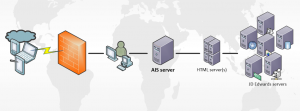The 101 on E1 Orchestrator
The 101 on E1 Orchestrator
Jonnel Tenorio, Sr. Techno-Functional Consultant
 Hello again from sunny Southern California!
Hello again from sunny Southern California!
JD Edwards E1 Orchestrator, is it a JDE module? What is it for? What do we need to run it? These are some of the questions that might pop up from folks that are hearing or reading about it for the first time.
For some it may sound overwhelming, for others it may just be another system or application to learn and integrate. In this article, I will attempt to provide ground level information to make us feel comfortable and excited. I will also start and throw in historical tidbits to help us understand where it started.
Internet of Things / Familiar Building Blocks
JD Edwards E1 Orchestrator can trace its roots from a type of JDE service between devices that was originally labeled by Oracle as the Internet of Things or IOT Orchestrator. Simply, IOT Orchestrator takes data from one device into another device and then to JD Edwards application(s) – a bit tedious to build and maintain requiring special skills. It morphed into a sophisticated bi-directional interface using modern and cool technology from Oracle. It is now further away from just interconnected devices because it exchanges information with third party systems and the cloud.
E1 Orchestrator provides key processing capabilities for practically all JD Edwards EnterpriseOne applications to service, consume and process data from internal applications, external devices and other software interfaces.
Originally aimed at Business Analysts and citizen developers, to build and extend JDE applications without touching application codes. It has now evolved and has been used by developers, technical resources, systems administrators as a tool to help them with their customizations, external interfaces and routine task in automating and providing information to their data consumers.
Is E1 Orchestrator a JDE module?
I have been in the JD Edwards space long enough that I associate a module or application set to business and system functions like the Homebuilder Management module, Real Estate Management, Apparel Management or the more popular Manufacturing and Financial modules that are implemented to process industry transactions and algorithm. Those modules or applications sets have their own JDE system ID – i.e., Homebuilder Management = 44H, Real Estate Management = 15, etc., - E1 Orchestrator does not have a designated system ID from JDE because we can build and launch it on top of practically every available JDE modules.
E1 Orchestrator offers processing capability for JDE EnterpriseOne modules or application sets to deliver, consume and process data within and between applications as well as from external devices and other software interfaces.
What is E1 Orchestrator for?
It is for the entire user population of JD Edwards EnterpriseOne. Functional and Business Analysts will be able to create, link, automate, simplify or extend a process without the need to revise programs (Citizen Developer). Developers now have another tool that allows them to build or enhance and interface applications using innovative and current technologies within the JD Edwards toolbox. Systems administrators transforms tedious, manual tasks into automated operations that meet the groups and JDE applications and key internal and external third-party systems they support.
All of the above, to provide timely, efficient and useful information to decision makers and folks running the organization.
What do we need to run E1 Orchestrator?
The foundation for E1 Orchestrator is the JDE EnterpriseOne AIS (Application Interface Services) server.
From Oracle: “The JD Edwards EnterpriseOne Application Interface Services (AIS) Server is the communication interface between JD Edwards EnterpriseOne and various AIS Server clients. The AIS Server provides a JSON over REST interface (HTTP), a light-weight interface that enables AIS clients to interact with EnterpriseOne applications and forms. Any client or software language that uses JSON over REST can interface with the AIS Server.” Below is high level view and I will save detail illustrations for future articles but to summarize, JDE EnterpriseOne AIS sits in the middle of JDE servers, web servers and various clients including mobile devices.

The other foundation for E1 Orchestrator is the E1 Orchestrator Studio.
Oracle invested a lot to make the JDE EnterpriseOne orchestrations easier and friendlier to create and maintain. Allowing citizen developers to create, test and deploy orchestrations in a single canvass or screen. The JDE EnterpriseOne Orchestrator Studio is an intuitive, graphical user interface that a non-developer can quickly learn and put into action and this interface is still evolving as I type this article.
If you are on JDE EnterpriseOne 9.2x, the Orchestrator Studio login screen looks similar except for the EnterpriseOne Orchestrator Studio label that was added to the product header and depending on the Orchestrator Studio release, the design screen and interfaces will vary. I’m sure we will spend more time to discuss in future articles.

There’s a lot more details to discuss and share and the goal of this article is to provide a skinny on JDE E1 Orchestrator with simple basic and foundation building blocks that goes with it. Per Oracle, this is one of the next big things (if not the best…) in the evolution of JD Edwards and everything is aligning great up to this point. So, stay tuned for future articles and webcasts, we at GSI are committed to guide our clients and spread the word on the values and benefits of E1 Orchestrator.
Let’s end this article consistent with the “The Fastpath and Furious…” article wrap up. This time from someone I don’t know personally but have followed for over twenty years. It felt different when I heard that I will no longer see the second half of the game he will play that will focus more on life and family: “We psyche ourselves up too much. Like if you try to talk yourself into, ‘Oh, this is a big moment, this is a big shot,’ you’re putting a lot of pressure on yourself. You shot that shot hundreds and thousands of times. Just shoot another one.” - Kobe Bryant, 2018
To find about GSI’s products or services including JDE project consulting services, managed services, upgrade services, cloud services, and more, call us at 855-GSI-4ERP or click on CONTACT US to send us a request for more information.
FOR MORE INFORMATION ON GSI'S JD EDWARDS SERVICE OFFERINGS
CONTACT US TODAY
FOR MORE INFORMATION ON GSI'S JD EDWARDS SERVICES
